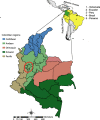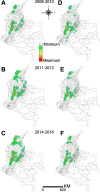The HIV epidemic in Colombia: spatial and temporal trends analysis
- PMID: 33478434
- PMCID: PMC7818909
- DOI: 10.1186/s12889-021-10196-y
The HIV epidemic in Colombia: spatial and temporal trends analysis
Erratum in
-
Correction to: The HIV epidemic in Colombia: spatial and temporal trends analysis.BMC Public Health. 2021 Apr 20;21(1):761. doi: 10.1186/s12889-021-10800-1. BMC Public Health. 2021. PMID: 33879113 Free PMC article. No abstract available.
Abstract
Background: Colombia has the fourth highest incidence rate of HIV/AIDS among all Latin American countries and it has been increasing since the 1980s. However, the number of studies that addresses this trend is limited. Here, we employed spatial and temporal trend analyses to study the behaviour of the epidemic in the Colombian territory.
Methods: Our sample included 72,994 cases of HIV/AIDS and 21,898 AIDS-related deaths reported to the National Ministry of Health between 2008 and 2016. We employed the joinpoint regression model to analyse the annual HIV/AIDS incidence and AIDS mortality rates. In the spatial analysis, we used univariate autocorrelation techniques and the Kernel density estimator.
Results: While the HIV/AIDS incidence had an increasing trend in Colombia, the AIDS mortality rate was stable. HIV/AIDS incidence and AIDS mortality showed a downward trend in the 0-14 age group. An upward trend was observed for HIV/AIDS incidence in people older than 15 years and with the highest trend in the 65 years and above group. AIDS mortality showed an increasing trend among people aged 65 years or older. The comparison between the sexes showed an upward trend of HIV/AIDS incidence in all age groups and AIDS-mortality rates in 65 years and above in men, while in women, the incidence was upward among those aged 45 years and above, and concerning the AIDS-mortality rate in the 45-64 group. The high-high clusters of HIV/AIDS incidence and AIDS mortality were located in the Andean and Caribbean regions.
Conclusion: Our study found an upward trend in HIV/AIDS incidence and a stable trend in the AIDS mortality rate in Colombia. The downward trend in HIV/AIDS incidence and AIDS mortality rate in the 0-14 age group reflects the downwards mother-to-child HIV transmission. The upward trend in HIV/AIDS incidence in older women and AIDS mortality in younger women rates, compared with men, may be due to late diagnosis and treatment. The Caribbean and the 'coffee belt' regions were the most impacted by the HIV epidemic, most likely due to sexual tourism. Our results provide crucial information that may help Colombian health authorities fight HIV transmission.
Keywords: Acquired immunodeficiency syndrome; Colombia; HIV; South America; Spatial analysis.
Conflict of interest statement
The authors declare that they have no competing interests.
Figures




Similar articles
-
Trends and disparities in 44 national notifiable infectious diseases in China: An analysis of national surveillance data from 2010 to 2019.J Med Virol. 2023 Jan;95(1):e28353. doi: 10.1002/jmv.28353. J Med Virol. 2023. PMID: 36443103 Free PMC article.
-
Temporal trend and spatial analysis of the HIV epidemic in young men who have sex with men in the second largest Brazilian Amazonian province.BMC Infect Dis. 2022 Feb 24;22(1):190. doi: 10.1186/s12879-022-07177-w. BMC Infect Dis. 2022. PMID: 35209850 Free PMC article.
-
HIV and HTLV-I infections in the Americas: a regional perspective.Medicine (Baltimore). 1989 Jul;68(4):189-209. doi: 10.1097/00005792-198907000-00001. Medicine (Baltimore). 1989. PMID: 2544782 Review.
-
The AIDS epidemic and economic input impact factors in Chongqing, China, from 2006 to 2012: a spatial-temporal analysis.BMJ Open. 2015 Mar 27;5(3):e006669. doi: 10.1136/bmjopen-2014-006669. BMJ Open. 2015. PMID: 25818270 Free PMC article.
-
Status of the HIV/AIDS epidemic and methods to monitor it in the Latin America and Caribbean region.AIDS. 2002 Dec;16 Suppl 3:S3-12. doi: 10.1097/00002030-200212003-00002. AIDS. 2002. PMID: 12685919 Review.
Cited by
-
Correction to: The HIV epidemic in Colombia: spatial and temporal trends analysis.BMC Public Health. 2021 Apr 20;21(1):761. doi: 10.1186/s12889-021-10800-1. BMC Public Health. 2021. PMID: 33879113 Free PMC article. No abstract available.
-
Human immunodeficiency virus epidemic scenery among brazilian women: a spatial analysis study.BMC Womens Health. 2023 Sep 1;23(1):463. doi: 10.1186/s12905-023-02616-5. BMC Womens Health. 2023. PMID: 37658362 Free PMC article.
-
HIV in Three Groups of Young People from Medellín: General Population, Organizations for People with Socioeconomic Vulnerability, and Men Who Have Sex with Other Men.HIV AIDS (Auckl). 2023 Nov 1;15:641-648. doi: 10.2147/HIV.S434036. eCollection 2023. HIV AIDS (Auckl). 2023. PMID: 37933247 Free PMC article.
-
Human immunodeficiency virus infection in pregnant women and its correlation with socioeconomic determinants.Rev Esc Enferm USP. 2023 Nov 20;57:e20220321. doi: 10.1590/1980-220X-REEUSP-2022-0321en. eCollection 2023. Rev Esc Enferm USP. 2023. PMID: 37997877 Free PMC article.
-
The impact of social violence on HIV risk for women in Colombia: A concurrent mixed methods study.PLOS Glob Public Health. 2023 Feb 24;3(2):e0001571. doi: 10.1371/journal.pgph.0001571. eCollection 2023. PLOS Glob Public Health. 2023. PMID: 36963089 Free PMC article.
References
-
- UNAIDS . Global HIV & AIDS statistics — 2019 fact sheet. 2019.
-
- GBD 2017 HIV collaborators Global, regional, and national incidence, prevalence, and mortality of HIV, 1980–2017, and forecasts to 2030, for 195 countries and territories: a systematic analysis for the Global Burden of Diseases, Injuries, and Risk Factors Study 2017. Lancet HIV. 2019;6(12):e831–e859. doi: 10.1016/S2352-3018(19)30196-1. - DOI - PMC - PubMed
Publication types
MeSH terms
LinkOut - more resources
Full Text Sources
Other Literature Sources
Medical

